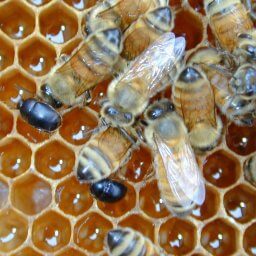Honey bee pests are a common problem for hives throughout the world. For new beekeepers, it can be a real challenge to know what to watch for and how to combat pests. This series is intended to give new beekeeping enthusiasts basic knowledge of the most common species that invade hives.

Honey Bee Pests and Diseases: Varroa Mites
Varroa destructor, Varroa jacobsoni
What are Varroa Mites?
As we’ve discussed in previous articles, varroa mites are tiny (typically less than 1 mm), oval-shaped arthropods that are relatively flat and brown in appearance. Varroa mites infest hives and feed on the bodily fluids of bees of all ages, including the larval, pupal and adult stages.
How do Varroa Mites Affect Bees?
In general, healthy hives with a good population of bees are able to withstand the effects of moderate varroa mite infestations. Because varroa reproduce in the brood, big, healthy colonies also rear lots of mites. Later in the season, during periods of slow population growth or reduced hive vitality, varroa mites may become a serious problem.
Since they are known carriers of many viruses that make bees sick, varroa infestations often leave honey bee colonies weakened and more susceptible to disease. Colonies infested with these mites often show developmental abnormalities as well, such as wing deformities.
How do I Combat Varroa Mites?
Chemical treatments, such as the thymol-based Apiguard and amitraz-based Apivar, have proven safe and effective treatments for reducing varroa mite populations in honey bee hives.
Mechanical measures are also effective at helping to reduce varroa mite levels, especially when combined with chemical treatments. Using a screened bottom board in your hives allows mites dislodged through grooming to fall out of the hive and away from the colony. The Bee Gym was designed to help this process by encouraging more effective grooming habits by bees.

Honey Bee Pests and Parasites: Small Hive Beetles
Aethina tumida
What are Small Hive Beetles?
The small hive beetle is a honey bee pest native to Africa that first appeared in North America in the late 1990s. In recent years, the small hive beetle has been detected in Central America, Australia and the southern Philippines as well.
The adult beetles are black or dark brown, and grow to about one-half centimeter. The larvae are white and about twice the length of the adults. During the pupa stage, small hive beetles burrow into the soil surrounding the hive before emerging as adults. Adult females then breed and lay eggs in cracks or small spaces in the hive to complete the lifecycle.
How do Small Hive Beetles Affect Bees?
It is the larvae of the small hive beetle that do the most damage to hives. These voracious eaters eat their way through combs as they feast on honey and pollen. In their wake, combs and caps are destroyed, and the larvae’s feces cause the honey to ferment and discolor. Many beekeepers report a tell-tale scent of decaying oranges in infested hives. In severe cases, colonies may completely abandon a hive due to these issues.
How do I Combat Small Hive Beetles?
Similar to varroa mites, small hive beetles are most problematic for weakened or underpopulated hives. While there are a few states that approve the use of organophosphate-based chemical treatments on an emergency basis, most beekeepers use mechanical means to control small hive beetles. Dadant & Sons carries a variety of beetle traps, such as the Small Hive Beetle Trap 10-Frame and the Mini Beetle Blaster.

Honey Bee Pests and Parasites: Wax Moths
Galleria mellonella, Achroia grisella
What are Wax Moths?
Wax moth larvae are off-white caterpillars with brownish-black feet and heads. They are considered pests by beekeepers, but are commercially raised as food for insect-eating pets such as lizards and some birds. The larvae, known as waxworms, are also sold as bait to anglers, and are even being investigated for their ability to digest polyethylene plastics!
How do Wax Moths Affect Bees?
Wax moths and waxworms do not directly attack honey bees. However, the destructive behavior of waxworms causes damage to comb and stored honey. This damage can lead to the death of bee larvae in the hive. Wax moths lay their eggs in hives because proteins found in used brood comb are vital to the development of waxworms into adult moths. In their search for these nutrients, waxworms chew through combs leaving frass, cocoons, spun tunnels and destroyed comb in their wake.
How do I Combat Wax Moths?
Like the other pests discussed in this article, healthy colonies do not typically have problems controlling waxworms in the hive. When weakened by disease or other issues affecting the colony’s population, however, bees may have trouble removing waxworms. Stored honey supers, especially supers with darker comb or stored pollen, are particularly susceptible to waxworm damage in warm climates or temperature-controlled buildings.
Wax moths and their larvae are easily killed by freezing temperatures. In warmer climates and warm storage facilities, para-dichlorobenzene products such as Para-Moth may be used to control infestations.
Read the next article in this series, Honey Bee Pests and Diseases, Pt. 2: Common Honey Bee Diseases!
Have questions? Give us a call at 888.922.1293 or contact the closest Dadant branch.
For beekeeping equipment and educational materials, visit our online store.